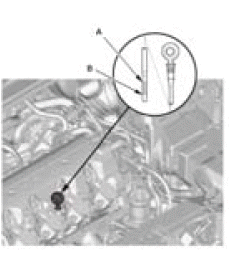Honda HR-V: Check
ENGINE OIL LEVEL CHECK
Check
1. Engine Oil Level - Check

- Park the vehicle on level ground, and start the engine. Hold the engine speed at 3, 000 RPM with no load (M/T in neutral, CVT in P or N) until the radiator fan comes on, then turn off the engine, and wait more than 3 minutes.
- Remove the dipstick, and wipe off the dipstick, then reinstall the dipstick.
- Remove the dipstick and check the engine oil level. It should be between the upper mark (A) and the lower mark (B).
- If the engine oil level is near or below the lower mark check for oil leaks, and add engine oil to bring it to the upper mark.
READ NEXT:
 Symptom Troubleshooting
Symptom Troubleshooting
ENGINE LUBRICATION SYSTEM SYMPTOM TROUBLESHOOTING - LOW OIL PRESSURE
INDICATOR DOES NOT COME ON WITH THE VEHICLE IN THE ON MODE
1. Input signal test:
Connect the HDS to the DLC.
Turn the vehicle to
 Starting System - Service Information
Starting System - Service Information
REMOVAL & INSTALLATION
ENGINE START/STOP SWITCH REMOVAL AND INSTALLATION
Removal and Installation
1. Dashboard switch Panel - Remove
2. Engine Start/Stop Switch - Remove
3. All Removed Parts - In
SEE MORE:
 Symptom Troubleshooting
Symptom Troubleshooting
AFTER WARMING UP, IDLE SPEED IS ABOVE SPECIFICATIONS WITHOUT LOAD (MIL
WORKS OK, NO DTCS SET) (KA/KC)
Diagnostic procedure
1. APP Sensor Signal Inspection
Also check for
Intake air leaks
AFTER WARMING UP, IDLE SPEED IS BELOW SPECIFICATIONS WITHOUT LOAD (MIL
WORKS OK, NO DTCS SET) (KA/KC)
Diagnostic
 HFL Microphone Removal and Installation
HFL Microphone Removal and Installation
Removal & Installation
1. HFL Microphone - Remove
Pull out the HFL microphone (A)
Disconnect the connector (B), then remove the HFL
microphone.
Remove the HFL microphone (A)
Remove the HFL microphone bracket (B) if
necessary.
2. All Removed Parts - Install
Install the parts in the
© 2019-2025 Copyright www.hohrv2.com

